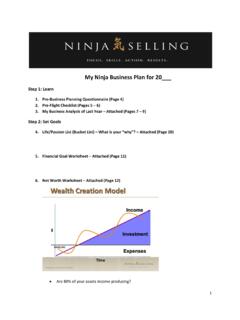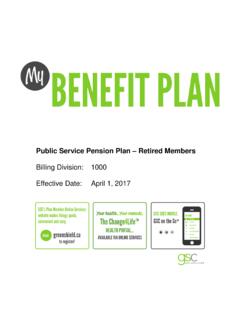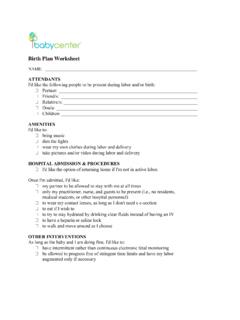Transcription of My WRAP Plan - NAMI Rockland
1 my wrap plan Materials adapted, with permission, by The University of Kansas School of Social Welfare 1995-2005 Mary Ellen Copeland, MS, MA All Rights Reserved Box 301, West Dummerston, VT 05357. Copeland Center for Wellness & Recovery Box 6464, Chandler, AZ 85246. (866) 436-9727 (toll-free) (480) 855-3282 (480) 855-5118 (fax) Personal Information This Wellness Recovery Action plan belongs to: Name Address City State Zip Telephone E-Mail Special instructions 1. What is wrap ? wrap stands for Wellness Recovery Action plan . wrap is a self-management and recovery system developed by a group of people who had mental health difficulties and who were struggling to incorporate wellness tools and strategies into their lives. wrap is designed to: Decrease and prevent intrusive or troubling feelings and behaviors Increase personal empowerment Improve quality of life Assist people in achieving their own life goals and dreams.
2 wrap is a structured system to monitor uncomfortable and distressing symptoms that can help you reduce, modify or eliminate those symptoms by using planned responses. This includes plans for how you want others to respond when symptoms have made it impossible for you to continue to make decisions, take care of yourself or keep yourself safe. People who are using wrap say: It helps me feel prepared.. I feel better more often and I'm able to improve the overall quality of my life.. The person who experiences symptoms is the one who develops their personal wrap . The person may choose to have supporters and health care professionals help them create their wrap . The wrap system was developed by people who have been dealing with a variety of psychiatric symptoms for many years and who are working hard to feel better and get on with their lives. Mary Ellen Copeland has shared it with people with other illnesses and they too believe that it can be easily adapted for use with other conditions.
3 Reprinted from Materials adapted, with permission, by The University of Kansas School of Social Welfare 1995-2005 Mary Ellen Copeland, MS, MA All Rights Reserved Box 301, West Dummerston, VT 05357 Copeland Center for Wellness & Recovery Box 6464, Chandler, AZ 85246 (866) 436-9727 (toll-free) (480) 855-3282 (480) 855-5118 (fax) 2. What People are Saying About wrap .. "Recovery & wrap have changed my life.". "I've gone from being totally disabled to being able to live a full and rich life. I am so grateful.". "Everything has improved at our organization. People are recovering and moving forward with their lives. Our work is so much more fulfilling.". Finally, something I can do to help myself.. I used to spend months, even years, in the hospital. Now I have a bad afternoon or a bad day. And it's all because I use wrap .. wrap for me is about personal responsibility.
4 I can just let my "symptoms" take over my life. Or I can take personal responsibility, use my wrap , and do what I need to do to take care of myself and feel better.. In the years that I have been using wrap , everything has changed in my life. I used to spend all my time just sitting around, watching TV and smoking. Now I hardly ever watch TV, I've given up smoking, I've gone back to school and I have a real job. And I have a wonderful partner. I. never thought life could be this good.. This has changed my life completely. I used to think of myself as this "mentally ill" person. Now I am a person who knows how to take care of myself and help myself in difficult time. If I am feeling badly or having a hard time, I take action. And there are so many simple, safe things I. can do.. When I was feeling badly I used to call the doctor or call the hotline. Now I check my list of Wellness Tools and do something I really enjoy.
5 Usually its call a friend to go for a walk, go to a movie, watch a video or just talk.. The word crisis has a different meaning for me now. I used to think it was a crisis when I felt really anxious and upset. I thought I needed to go into the hospital or get my medications increased. Now a crisis is when everything is so bad I need others to take over for me. And I. don't have them anymore, because now I know how to take care of myself.. Reprinted from Materials adapted, with permission, by The University of Kansas School of Social Welfare 1995-2005 Mary Ellen Copeland, MS, MA All Rights Reserved Box 301, West Dummerston, VT 05357 Copeland Center for Wellness & Recovery Box 6464, Chandler, AZ 85246 (866) 436-9727 (toll-free) (480) 855-3282 (480) 855-5118 (fax) 3. wrap : The Wellness Recovery Action plan by Mary Ellen Copeland, MA, MS. wrap is a self-designed plan for staying well and for helping you to feel better when you are not feeling well to increase personal responsibility and improving your quality of life.
6 The first part of wrap is developing a personal Wellness Toolbox. This is a list of resources you can use to develop your wrap . It includes things like contacting friends and supporters, peer counseling, focusing exercises, relaxation and stress reduction exercises, journaling, creative, fun and affirming activity, exercise, diet, light, and getting a good night's sleep. Section 1 of wrap is the Daily Maintenance plan . It includes three parts: 1.) a description of yourself when you are well, 2.) those Wellness Tools you know you must use every day to maintain your wellness, and 3.) a list of things you might need on any day. Section 2 is identifying those events or Triggers that, if they happened, might make you feel worse--like an argument with a friend or getting a big bill. Then, using Wellness Tools, you develop an action plan you can use to get through this difficult time.
7 Section 3 is identifying Early Warning Signs, those subtle signs that let you know you are beginning to feel worse, like being unable to sleep or feelings of nervousness. Then, again, using your Wellness Toolbox, developing an action plan for responding to these signs you feel better quickly and prevent a possible difficult time. Section 4 is When Things are Breaking Down. In this section, you list those signs that let you know you are feeling much worse, like you are feeling very sad all the time or are hearing voices. And again, using your Wellness Toolbox, develop a powerful action plan that you that will help you feel better as quickly as possible and prevent an even more difficult time. Section 5 is a Crisis plan or Advance Directive. In the crisis plan , you identify those signs that let others know they need to take over responsibility for your care and decision making, who you want to take over for you and support you through this time, health care information, a plan for staying at home through this time, things others can do that would help and things they might choose to do that would not be helpful.
8 This kind of proactive advanced planning keeps you in control even when it seems like things are out of control. Section 6 is the Post Crisis plan . You may want to think about this part of the plan in advance and even write some things to do in that time. However, you may want to write most of it as you Materials adapted, with permission, by The University of Kansas School of Social Welfare 1995-2005 Mary Ellen Copeland, MS, MA All Rights Reserved Box 301, West Dummerston, VT 05357 Copeland Center for Wellness & Recovery Box 6464, Chandler, AZ 85246 (866) 436-9727 (toll-free) (480) 855-3282 (480) 855-5118 (fax) 4. are beginning to recover from the crisis when you have a clearer picture of what you need to do for yourself to get well. Review your plans every day, noting how you feel and doing what you need to do to help yourself get better or to keep yourself well.
9 As you become familiar with your plan , you will find that the review process takes less time and that you will know how to respond without even referring to the book. People who are using these plans regularly and updating them as necessary are finding that they have fewer difficult times, and that when they do have a hard time it is not as bad as it used to be and it doesn't last as long. The wrap approach empowers you to take control of your own health and wellness. Since its development, the system has been shared with thousands of people through the books Wellness Recovery Action plan and Winning Against Relapse, the Winning Against Relapse audio tape, the Creating Wellness video series, numerous support groups, workshops and seminars, and through the web site. Copeland Center for Wellness & Recovery Box 6464 Chandler, Arizona 85246. (866) 436-9727 (toll-free) (480) 855-3282 (480) 855-5118 (fax).
10 E-mail Materials adapted, with permission, by The University of Kansas School of Social Welfare 1995-2005 Mary Ellen Copeland, MS, MA All Rights Reserved Box 301, West Dummerston, VT 05357 Copeland Center for Wellness & Recovery Box 6464, Chandler, AZ 85246 (866) 436-9727 (toll-free) (480) 855-3282 (480) 855-5118 (fax) 5. How to Use the wrap Program Reprinted from Wellness Recovery Action plan by Mary Ellen Copeland, MS, MA. Published by Peach Press 1995-2005. In order to use this program successfully, you have to be willing to spend up to 15 or 20 minutes daily reviewing the pages, and be willing to take action if indicated. Most people report that morning, either before or after breakfast, is the best time to review the book. As you become familiar with your symptoms and plans, you will find that the review process takes less time and that you will know how to respond to certain symptoms without even referring to the book.







